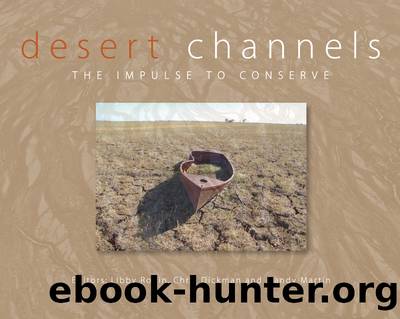Desert Channels by Robin Libby;Dickman Chris;Martin Mandy;

Author:Robin, Libby;Dickman, Chris;Martin, Mandy;
Language: eng
Format: epub
Publisher: CSIRO Publishing
Suite for Season 2008,
Mandy Martin.
Painted Gorge, Cravens Peak Reserve, Simpson Desert, 2008. Pigments/ochres/acrylic on canvas. 100 Ã 100 cm.
Aesthetic evaluation demands a visual vocabulary with which to assess the landscape. I see this process as being similar to collecting scientific data. It is an intensive process, based on sampling and resampling, reliant on a consistent methodology or approach and susceptible to interference from many variables. Ultimately, its aim is to represent the diversity that makes functioning landscapes visually pleasing.
Desert channels landscapes are visually pleasing to me but for many people who have never before been in such a landscape, it is difficult to know what to âreadâ or how to âseeâ it. So I stand in the blazing sun with flies crawling into my eyes, up my nose and into my paint for 8â10 hours, tramping back and forth between four canvases spread around the landscape capturing different viewpoints. Why donât I simply photograph or write down these visual qualities? I often do these things as well but as an artist I intuitively select and exaggerate features in the landscape, sometimes rearranging them to make a coherent visual composition. Artists open a path for viewers to see the visually valuable or special features of a landscape.
Some landscape assessments are done in words but my evaluations are visual. The art work is the document and it aids different ways of visualising the place, just as a scientific assessment can aid consideration of animals or plants or water flows, by documenting their role in the landscape. William L. Fox, exploring the relations between landscape and cognition in interdisciplinary projects like this one, says âMaps are paintings, paintings are strategic documents, documents read like poems, habitat becomes sculpture, and sculpture erodes into an archaeological ruin.â1
Each reading informs the next. By working with ecologists, historians, pastoralists and others with viewpoints on the landscape, the aesthetic view of it is integrated into a larger project that can value â and perhaps conserve â landscapes in more ways.
As we move closer to the surface of the painting, the actual depth in the picture plane reveals itself. Like a real landscape (and unlike a photograph) the viewer can experience the sensuousness of texture. The marks are abstract but they are not âhomelessâ: they are part of a larger form and they are also representational. Such visual information is subjective, but it is also available for appreciation by any viewer. Thus I suggest that aesthetic evidence should be admitted as part of a well-rounded environmental appreciation.
Driving into mobile phone range at Cunnumulla after two weeks painting in the desert, I received an email from London-based geographer David Lowenthal, with an attached essay: âliving with and looking at landscapeâ. While contemplating the wonders of leaf litter in the dry creek bed of the Mulligan River, I had recalled Davidâs fascination with dappled light, something that is rare in city lives. I believe a healthy functioning system is an aesthetically pleasing one but David, in this essay and in previous lectures, takes a different view.
Download
This site does not store any files on its server. We only index and link to content provided by other sites. Please contact the content providers to delete copyright contents if any and email us, we'll remove relevant links or contents immediately.
Man-made Catastrophes and Risk Information Concealment by Dmitry Chernov & Didier Sornette(5921)
The Revenge of Geography: What the Map Tells Us About Coming Conflicts and the Battle Against Fate by Kaplan Robert D(4035)
Zero Waste Home by Bea Johnson(3780)
COSMOS by Carl Sagan(3554)
Good by S. Walden(3488)
In a Sunburned Country by Bill Bryson(3485)
The Fate of Rome: Climate, Disease, and the End of an Empire (The Princeton History of the Ancient World) by Kyle Harper(3003)
A Wilder Time by William E. Glassley(2818)
Camino Island by John Grisham(2762)
The Ogre by Doug Scott(2631)
Organic Mushroom Farming and Mycoremediation by Tradd Cotter(2626)
Human Dynamics Research in Smart and Connected Communities by Shih-Lung Shaw & Daniel Sui(2466)
Energy Myths and Realities by Vaclav Smil(2438)
The Traveler's Gift by Andy Andrews(2409)
9781803241661-PYTHON FOR ARCGIS PRO by Unknown(2323)
Inside the Middle East by Avi Melamed(2305)
Birds of New Guinea by Pratt Thane K.; Beehler Bruce M.; Anderton John C(2226)
A History of Warfare by John Keegan(2186)
And the Band Played On by Randy Shilts(2129)
